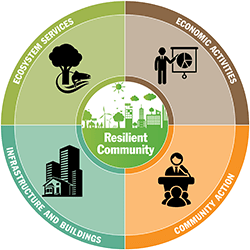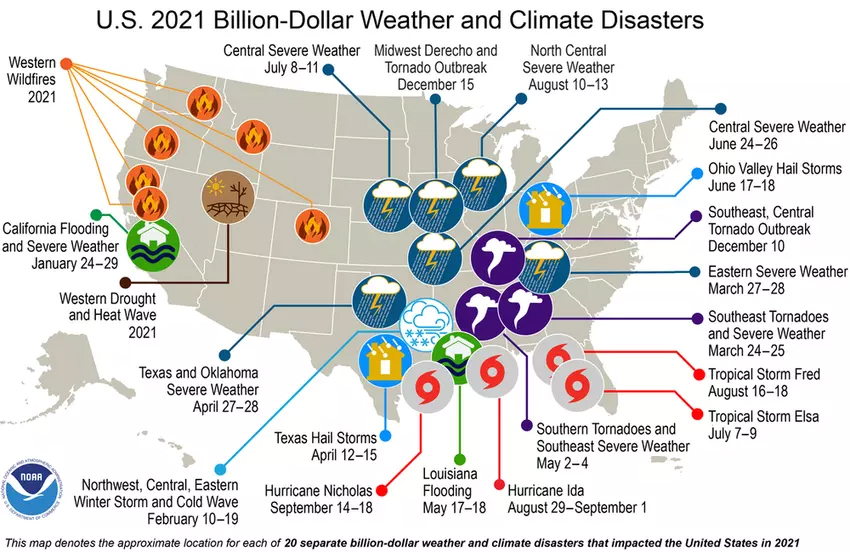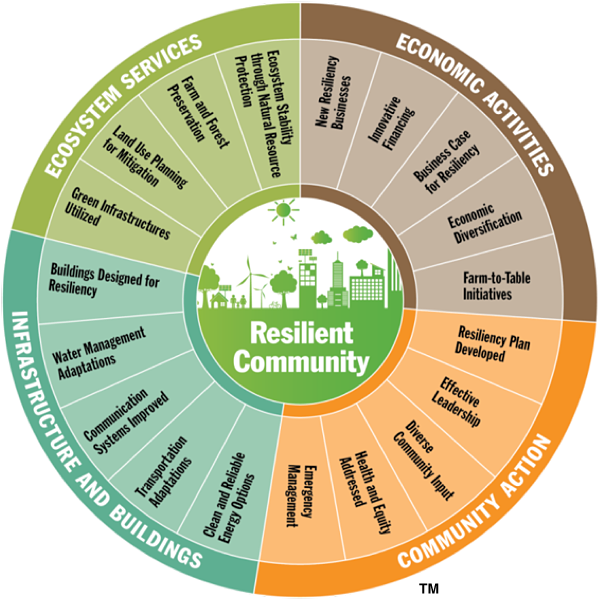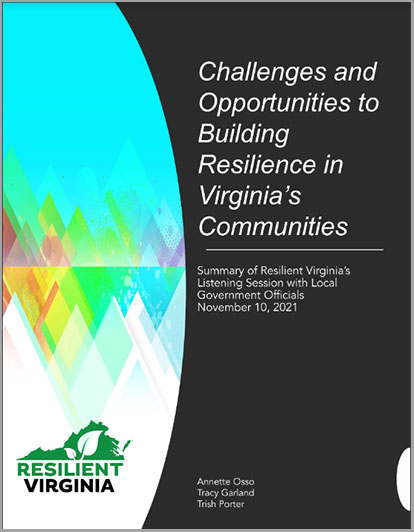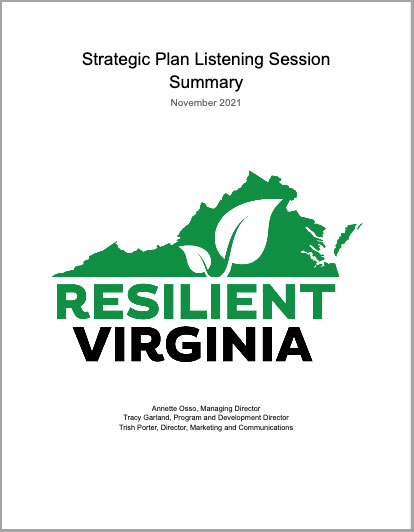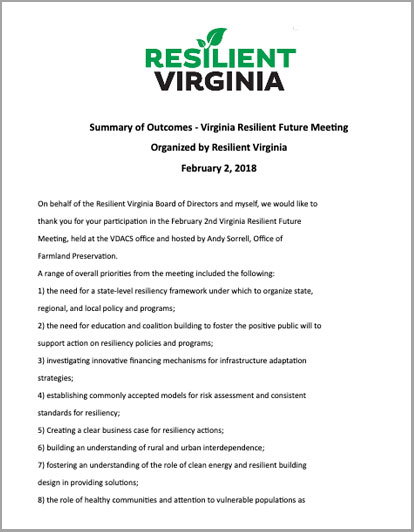Accelerating resiliency planning in communities across the Commonwealth
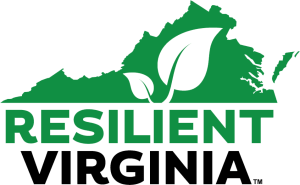
STRATEGIC PLAN
July 2021–June 2026
Accelerating resiliency planning
in communities across the Commonwealth.
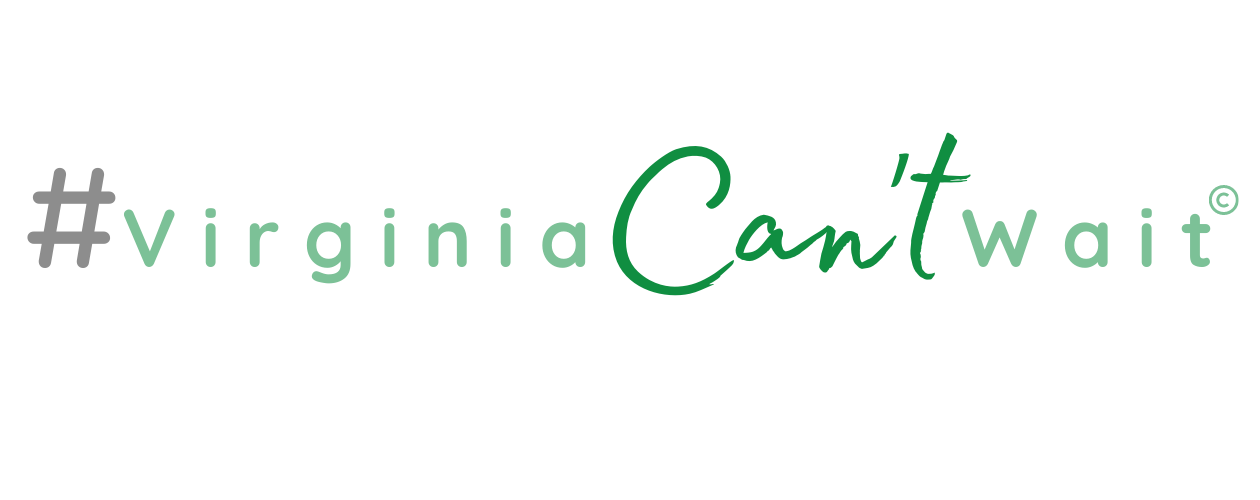
RESILIENT VIRGINIA STRATEGIC PLAN: JULY 2021–JUNE 2026
EXECUTIVE SUMMARY

Who We Are
Resilient Virginia was established in 2014 with the mission of accelerating resiliency planning in communities across Virginia. The organization has an extensive history of working in the state since 1995, as the Virginia Sustainable Building Network.
Definition of Resilience
Resilience is the ability to identify risk while building the capacity to maintain or rapidly regain functionality and vitality in the face of chronic stressors or severe disturbances.
- For the short term, resilience planning enables communities to better address extreme weather, pandemics, and other high impact events.
- For the long term, community resilience provides the ability to adapt and thrive despite changing climate, environmental, social, and economic conditions.
What Makes a Community Resilient
Communities that seek to strengthen their capacity to address physical and socio-economic challenges need to address four major components of resiliency that focus on 1) Infrastructure and Buildings; 2) Community Actions; 3) Economic Activities; and 4) Ecosystem Services.
Depending on a community’s location — coastal, urban, or rural — they will identify particular priority risks and solutions when developing a roadmap to resilience. Cities in Hampton Roads and Northern Virginia, for example, have identified infrastructure adaptation, land use planning, and social equity as critical components, while rural communities view systemic economic challenges and ecosystem preservation as ongoing challenges.
Resilient Virginia Vision, Mission, and Goals
Our Vision: Virginia communities adapt to climate, environmental, social and economic challenges to become more resilient, healthy, and safe places to live, work, and prosper.
Our Mission: To accelerate resiliency planning in communities across the Commonwealth.
Our Goals: To inform diverse community representatives around the Commonwealth about natural, climate-related, and man-made challenges; to educate key groups about models for community resiliency planning; and to activate these communities to engage in resiliency plan development.
What Resilient Virginia Offers
To inform, educate, and activate critical constituencies, Resilient Virginia provides:
- A Resource Hub for information on capacity-building tools and resources that assist communities in dealing with:
- Climate change impact
- Environmental hazards
- Energy, water, and food security
- Societal and economic stressors
- Health and social equity
- Security threats.
- Workshops and training for local governments and community organizations, which provide technical knowledge aligned with state and federal-level policy priorities. A Resiliency Academy series, established in 2020, is being continued, with topics that include resiliency planning “how-to’s” for local governments, disaster mitigation funding, economic impact and opportunities, resilient building and infrastructure design, and the role of ecosystems in community resilience.
- Statewide conferences, which report on progress, help define ongoing challenges, and propel implementation of policy agendas. Our latest conference was the 2021 Resilient Virginia conference: From Recovery to Resilience—Moving to Vibrant, Healthy, and Equitable Communities.
- The next conference is planned for 2023.
- Direct consulting services to jurisdictions and planning district commissions seeking assistance in resiliency planning and implementation.
RESILIENT VIRGINIA STRATEGIC PLAN: JULY 2021–JUNE 2026
ORGANIZATIONAL DESCRIPTION
Background

Resilient Virginia was formed to build on the successes of our founding organization, Virginia Sustainable Building Network (VSBN), which carried out educational activities in Virginia, centered around Green Building and Sustainable Development, from 1995 to 2013. In 2014, the VSBN staff and Board of Directors decided to leverage the extensive experience and statewide networks of that organization to reformulate a new entity that could facilitate a wider mission of accelerating resiliency planning. Resilient Virginia’s Board of Directors and staff together bring to the organization a 30 plus-year range of experience and expertise.
You can find out more information about our history and accomplishments in the “Who We Our’ section of the Resilient Virginia website.
The Need for Resilient Virginia
In the United States, and globally, there are increasing numbers of risks to the normal functioning of communities. These challenges are more frequently taking the shape of climate-driven and natural disasters, such as tornadoes, floods, hurricanes, wildfires, heat waves, and earthquakes, as well as the recent global COVID pandemic. Human-induced stressors also abound, including acts of terrorism and war, economic crises, and social upheavals.
The 4th National Climate Assessment (NCA) Report (2018) stated:
Earth’s climate is now changing faster than at any point in the history of modern civilization, primarily as a result of human activities. The impacts of global climate change are already being felt in the United States and are projected to intensify in the future—but the severity of future impacts will depend largely on actions taken to reduce greenhouse gas emissions and to adapt to the changes that will occur.
The report concludes:
While Americans are responding in ways that can bolster resilience and improve livelihoods, neither global efforts to mitigate the causes of climate change nor regional efforts to adapt to the impacts currently approach the scales needed to avoid substantial damages to the U.S. economy, environment, and human health and well-being over the coming decades.
Virginia, as part of the Southeastern United States, faces environmental and climate challenges, as reported in the 4th National Climate Assessment, that include:
- Sea level rise, which poses widespread and continuing threats to both natural and built environments, as well as the regional economy.
- Rising temperatures and the associated increase in frequency, intensity, and duration of extreme heat events, which affect public health, increase mortality, and will affect natural and built environments, energy, agriculture, and forestry.
- Decreased water availability, exacerbated by population growth and land-use change, which will continue to increase competition for water and impact the region’s economy and unique ecosystems.
- An increase in extreme weather events, such as the 2012 derecho, hurricanes, severe thunderstorms, and tornados, which result in flooding, property damage, and power outages.
In addition, our communities deal with a variety of man-made stresses.
- As part of the international community, the state faces the possibility of man-made threats, such as acts of terrorism (both foreign and domestic), as well as health emergencies and pandemics.
- Globalization of businesses, shifting state economics, and long-standing inequities result in societal stresses that can manifest themselves in loss of employment opportunities, increased community violence, homelessness, a decline in medical services, and local food and housing insecurity.
In August 2021, the 6th Intergovernmental Panel on Climate Change Report was published and brought heightened awareness that climate change impacts are already widespread and rapidly intensifying. Increasing numbers of nations are facing health, economic, and social risks, while businesses around the world face enormous financial risk. The Secretary-General of the United Nations called the report a “code red for humanity.” He cited the fact that we will not succeed in capping warming from GHG emissions to 1.5 degrees Celsius by the 2030s, unless immediate and intensive actions are taken by the world’s nations to mitigate emissions, while citing the need to move forward to create more inclusive and greener economies.
(Source: https://www.climate.gov/news-features/understanding-climate/climate-change-global-temperature)
Additional reports from NASA, NOAA, and Berkeley Earth, released in January 2022, indicate that the past seven years (2015–2021) have been the hottest in recorded history, with increasing societal and infrastructure disasters across the U.S. and across the world. In 2021, the U.S. endured at least 20 weather disasters costing $1 billion or more, which included the full range of severe weather events, droughts, hurricanes, and tornadoes.
Here in Virginia, severe storm events causing billions of dollars of damage have increased in frequency, while the coastal areas have the highest rates of sea level rise along the entire Atlantic seaboard and are second only to New Orleans as the largest U.S. population centers at risk.* In addition, more frequent heat waves, drought, and severe weather events are impacting farm and forest production, as well as other economic activities.
*(Source: https://coast.noaa.gov/states/stories/sea-level-rise-adaptation-advances-on-multiple-fronts.html)
Source: NOAA National Centers for Environmental Information (NCEI) U.S. Billion-Dollar Weather and Climate Disasters (2022). https://www.ncdc.noaa.gov/billions/, DOI: 10.25921/stkw-7w73
The U.S. government, as well as national organizations and some state governments, have recognized that dealing primarily with post-disaster or post-crisis provision of emergency services and rebuilding efforts is costly and inadequate. In contrast, communities that proactively take steps to address basic resiliency preparedness will be most successful in strengthening community relationships that bolster the ability to function in the event of disruptive events, as well as long-term environmental or economic downturns.
While the term resilience has a number of interpretations, resilience is commonly defined as the ability to identify risks while building the capacity to maintain or regain functionality and vitality in the face of natural or man-made disturbances. Community resiliency provides the ability to adapt and thrive despite changing environmental, social, and economic conditions.
This proactive approach has been confirmed by the lessons learned from dealing with the two-plus years of the COVID-19 pandemic. Governments, communities and businesses have realized some enduring and relevant lessons including that:
Virginia Disasters: 2016–2021
| Disaster Type | Number of Events | Total Cost | Percent of Total Cost |
| Drought | – | – | – |
| Flooding | 1 | $5M-$100M | 0.6% |
| Freeze | 1 | $5M-$100M | 0.3% |
| Severe Storm | 19 | $1B-$2B | 30.9% |
| Tropical Cyclone | 9 | $2B-$5B | 49.5% |
| Wildfire | – | – | – |
| Winter Storm | 3 | $500M-$1B | 18.7% |
| All Disasters | 33 | $2B-$5B | 100% |
- Climate impact, like the pandemic, has no state or national borders;
- The “first and worst” impacted people and communities are those already facing heightened vulnerability from poverty and under-representation;
- Taking preemptive actions before disaster strikes works best and are more cost-effective; and
- Solutions need to be inclusive, systemic, and based on science.
- The Homeland Security Advisory Council’s Community Resilience Task Force Recommendations (https://www.dhs.gov/xlibrary/assets/hsac-community-resilience-task-force-recommendations-072011.pdf);
- National Academy of Sciences Resilient America Roundtable http://sites.nationalacademies.org/PGA/resilientamerica/;
- Resiliency initiatives of the National Association of Counties, National League of Cities, Urban Land Institute, and other national organizations;
- Private initiatives such as the USGBC and the RELI design guide and the Envision guide that address resiliency in buildings, infrastructure and communities;
- The urban resiliency initiatives supported by the 100 Resilient Cities program (resilientcitiesnetwork.org); and
- Community and state initiatives being undertaken throughout the United States (see Georgetown Climate Center Adaptation Clearinghouse and NOAA’s Climate Case Studies).
- Building a national campaign to strengthen and sustain national resilience;
- Working with key stakeholder groups to develop and share models for resilience;
- Building the knowledge and talent base for resilience;
- Building public awareness and motivating individual and community engagement;
- Facilitating community-based resilience assessment by developing a community-based, all-hazards methodology and toolkit; and
- Enabling community-based resilience initiatives through funding and policy support.
Resilient Virginia’s Approach
Resilient Virginia is an organization intent on moving resiliency initiatives forward, at both the state and local levels by taking an educational and action-oriented approach. Resilient Virginia’s Staff and Board of Directors, working in collaboration with a wide range of public and private partners at the federal, state, and local levels, have the capacity to assemble diverse audiences to engage in learning about new concepts, to enhance interaction among different community sectors, and to promote understanding of how to utilize a range of tools for resiliency planning. Resilient Virginia works to integrate the best national and local resiliency resources and tools to continually update our Virginia-based Resource Hub that can be used by communities to be better prepared for climate, social, or economic uncertainties, while adapting to changing long-term conditions. Resilient Virginia utilizes its expert staff and partner resources to reach out to normally disaggregated groups — such as the chambers of commerce, faith groups, local and regional governments, K–12 schools and higher education, civic and environmental groups, the healthcare sector, disadvantaged and minority populations, and major corporations — within a community, to engage them in mutually beneficial educational initiatives focused on resiliency strategy development. By educating diverse elements of communities and building collaborative relationships, community structure can be more inclusive, cohesive, and resilient. These resilient communities, whether in coastal, urban, or rural areas, can more successfully continue to function as centers of production and sources of essential services and resources despite challenges they face. In summary, our approach strives to:- Bring a statewide approach to the forefront to highlight the diverse risks facing communities across the Commonwealth;
- Work across institutional and political silos to educate multiple community elements;
- Build collaborative relationships so that communities are more inclusive, cohesive. and productive when addressing their challenges; and
- Activate communities to strengthen physical and societal infrastructure so they continue to function as centers of production, sources of essential services, and equitable communities despite the range of natural, man-made and technological risks and economic, environmental, and societal challenges that they face.
What Resilient Virginia Offers
During its first seven years, Resilient Virginia has engaged in a variety of educational events and activities that include community-based interactive events, joint presentations with partner organizations, training for resiliency practitioners through the Resiliency Academy series, and statewide Resilient Virginia Conferences. Resilient Virginia has also embarked on providing direct consulting services to local governments. Resilient Virginia provides the following services to carry out its mission of accelerating resiliency planning across the Commonwealth.- A Resource Hub for information on capacity-building tools and resources that assist communities in dealing with:
- Natural, man-made, and technological hazards, including impacts from climate change
- Environmental challenges
- Energy, water, and food security
- Societal and economic stressors
- Health and social equity
- Local and national security threats.
- Workshops and training for local governments and community organizations, which provide technical knowledge aligned with state and federal-level policy priorities. A Resiliency Academy series, established in 2020, will continue through 2022 and 2023, with topics to include resiliency planning “how-to’s” for local governments, disaster mitigation funding, economic impact and opportunities, resilient building and infrastructure design, and the role of ecosystems in community resilience.
- Statewide conferences, which report on progress, help define ongoing challenges, and propel implementation of policy agendas. Our latest conference was the 2021 Resilient Virginia conference: From Recovery to Resilience-Moving to Vibrant, Healthy, and Equitable Communities.
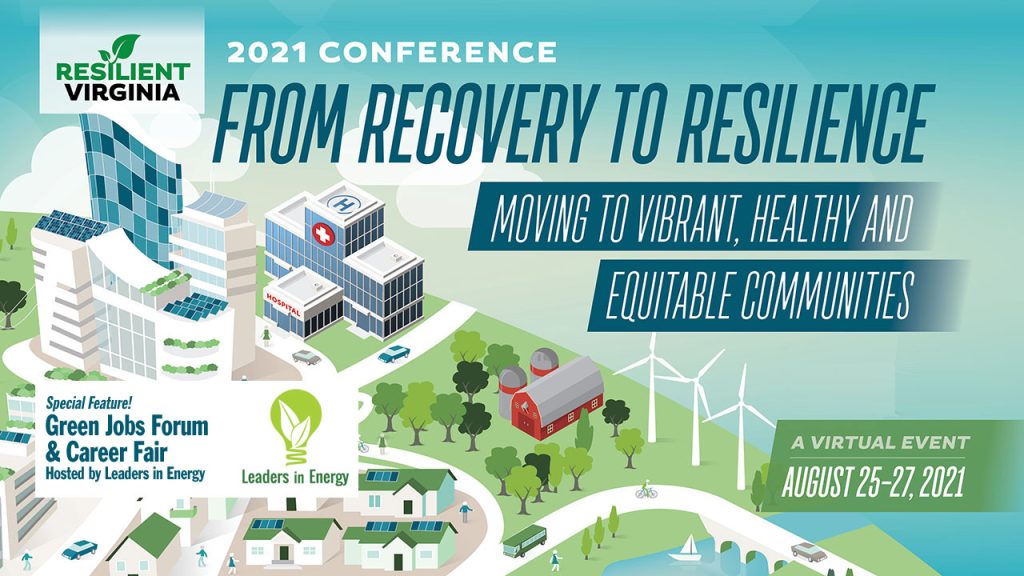
The next conference is planned for 2023.
- Direct consulting services to jurisdictions and planning district commissions seeking assistance in resiliency planning and implementation.
Find out more about Resilient Virginia’s accomplishments here.
RESILIENT VIRGINIA STRATEGIC PLAN: JULY 2021–JUNE 2026
VISION, MISSION, AND VALUES
Vision Statement
Virginia communities, including local governments, institutions, businesses, and households, will gain the ability to better adapt to climate, environmental, social, and economic challenges while remaining healthy, vibrant, and safe places to live, work, and raise future generations.Mission Statement
Our mission is to accelerate resilience planning in communities across the Commonwealth.Value Statements
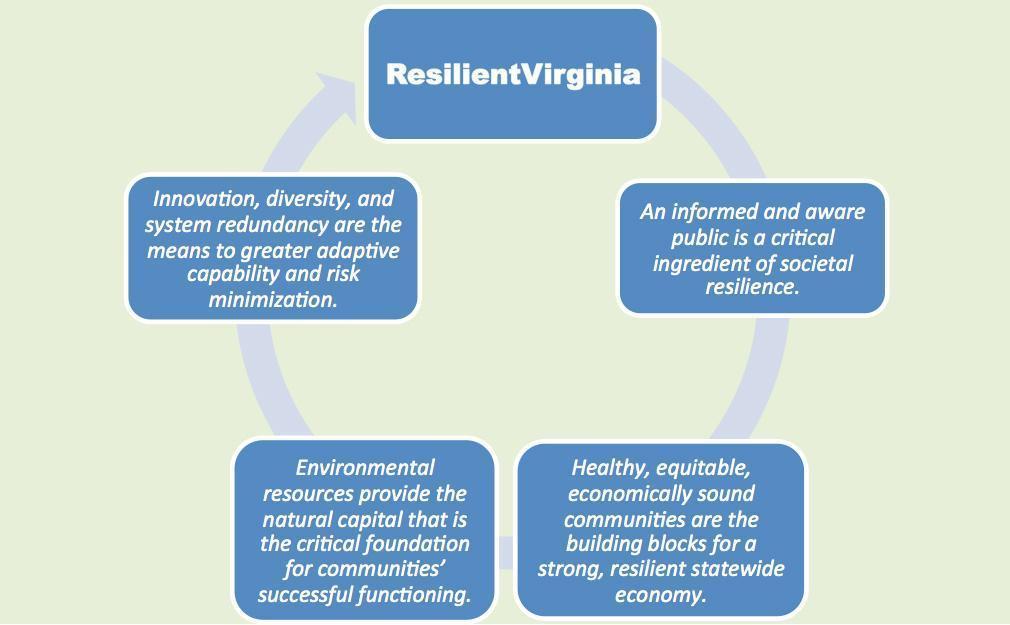
- Resilient Virginia supports the concept that healthy, equitable, economically sound communities are the building blocks for a strong, resilient statewide economy.
- Resilient Virginia supports the idea that an informed and aware public is the best foundation through which to build societal resilience.
- Resilient Virginia recognizes that environmental resources provide the natural capital that is the critical foundation for our communities’ successful functioning.
- Resilient Virginia sees innovation, diversity, and system redundancy as means to greater adaptive capability and risk minimization when facing natural and man-made challenges, whether extreme events or ongoing stressors.
RESILIENT VIRGINIA STRATEGIC PLAN: JULY 2021–JUNE 2026
GOALS, OBJECTIVES, AND ACTION ITEMS
Resiliency Program Goals: July 2021–June 2026
Our overall program goals are:- to inform diverse community representatives around the Commonwealth about natural (including climate-related), technological, and man-made risks and other long-term stressors
- to educate key groups about models for community resilience planning; and
- to activate these communities to develop and implement resiliency action plans.
Areas of focus:
Equity as the Foundation of Resiliency Planning
Low-income communities and those with an aggregation of people of color or other marginalized groups are often the most vulnerable, whether to health disasters or weather-related disasters, and are disproportionately underserved in recovery operations. We want to applaud the initiatives from the past four years at the state level that included a close coordination between the Virginia Department of Emergency Management and the Virginia Department of Health, to develop programs and training to help focus resources to these communities around the state. Resilient Virginia takes the position that equity and environmental justice concerns must be a foundation that will be addressed in local, regional, and state resiliency planning initiatives. This includes making sure that communities of color and other under-represented groups are provided opportunities to learn more about natural (including climate change impacts and public health events), technological, and man-made risks and are allowed a place at the table when resiliency planning is undertaken.The 2021 Strategic Planning Listening Sessions
The 2021 Listening Sessions were held in November-December 2021 to solicit input from key organizations, governments, and academic sources about challenges and opportunities in the four main areas of resiliency: economics, ecosystem services, community actions, and infrastructure and buildings. We also encouraged participants to share their ideas on the best role for Resilient Virginia to achieve our mission of accelerating resiliency planning in communities across the Commonwealth. The new program goals listed here are influenced by the results of these sessions. The summary of the Listening Session Notes is included in Appendix A of the Strategic Plan.The 2018 Strategic Visioning Meeting
As a result of the 2018 Strategic Visioning Meeting, Resilient Virginia formed the four-part concept of community resiliency and agreed on a focus that emphasizes rural-urban interdependence with special emphasis on jurisdictions in the Central and Southwestern parts of the state. The summary of the 2018 visioning session is included in Appendix B of the Strategic Plan.Considering the input from these two planning sessions, as well as the results from our initiatives that we have instituted over the past seven years, Resilient Virginia will prioritize these areas for 2021–2026:
- Continue to focus and expand our program activity that educates stakeholders on the need for resiliency planning and provides technical assistance to local and regional governments in the central and southwestern regions of the state;
- Promote the need for a statewide resiliency plan that builds on the extensive climate resilience efforts of coastal communities that resulted in the Coastal Master Resiliency Plan, which was published in 2021; and
- Work to integrate concepts of equity and environmental justice into our educational and action agendas.
Program Goals, Objectives, and Action Items: July 2021–June 2026
Goal #1: Inform communities on priority topics related to resiliency.
Objective — Continue to identify information outlets and add resources to the website and social media that bring federal, state, regional, and local printed and virtual materials to public and private stakeholders and the general public on the range of resiliency topics in the four areas of resiliency: economics, ecosystem services, community actions, and infrastructure and buildings.
Action Item #1 (Years 1–5): Expand the Resource Hub on the website through staff, interns, and volunteer initiatives.
Action Item #2 (Years 1–5): Continue the Quarterly Newsletter through staff, intern, guest writers, and volunteer initiatives.
Action Item #3 (Years 1–5): Continue the new Member Brief (started in February 2020) on a twice monthly schedule through staff, intern, and volunteer initiatives (contingent on adequate staffing capacity).
Action Item #4 (Years 1–5): Continue the social media posts on Facebook, Twitter, LinkedIn, and other social media outlets through staff and volunteer initiatives.
Goal #2: Educate local, regional, and state government officials, community organizations, businesses, and individuals.
Objective — Continue educational initiatives that highlight the need for resilience planning, provide the tools for developing and implementing resilience plans, and identify potential sources of funding for resilience planning.
Action Item #1 (Years 1–5): Plan and carry out statewide Resilient Virginia Conferences in Fiscal Years 2021, 2023, and 2025, respectively, with partners, funders, and a Planning Committee. The Conferences bring together participants from government, academic, community, and business sectors with the purpose of highlighting resiliency resources and planning tools; tracking local, state and national progress; bringing forward case studies from rural, urban and coastal areas; and emphasizing national and state policies needed to further climate adaptation initiatives.
Action Item #2 (Years 1–2): Continue to develop opportunities for joint presentations with partner organizations on priority resiliency topics.
Action Item #3 (Years 2–5): Develop and initiate a Resiliency Star Speakers series that highlights exceptional work in resiliency being carried out in the academic and consulting areas to advance state-of-the-art climate adaptation initiatives.
Action Item #4 (Years 2–5): Work with higher education institutions and workforce development programs to provide on-the-ground opportunities for climate-related education and experience and climate-related workforce development training that creates new resiliency-focused business opportunities.
Goal #3: Activate communities to develop and implement resiliency action plans.
Objective — Conduct resiliency workshops and bring technical assistance to rural and urban communities to facilitate resilience planning and implementation.
Action Item #1 (Years 1–2): Develop and manage two four-part Resiliency Academy workshop series in each year with the goal of bringing useful toolkits, funding sources, and topic experts to an audience of government, business, and community representatives. Staff and consultants will work on the delivery of these workshops, contingent on funding support. Review this approach after FY 2023 to assess whether this initiative should be extended through 2026.
Action Item #2 (Years 1–5): Provide direct resiliency technical assistance to jurisdictions and planning district commissions This activity will be executed by staff and a consulting team, contingent on funding support.
Goal #4: Support program and policy development at the national, state, local, and regional levels.
Objective — Support the forward movement of initiatives to meet the challenge of climate impact and other major risk factors, as well as health, social and economic issues, while fostering social equity as a basis of resiliency planning.
Action Item #1 (Year 2–3): Develop and implement the thematic approach embodied in the #Virginia Can’t Wait slogan so that our local, regional and state initiatives reflect this emphasis. Solicit partner organizations to join with us in promoting this theme with the joint goal of keeping the threat of natural and man-made challenges, and the availability of tools for tackling this threat, in front of our leaders and community members, regardless of state-level leadership.
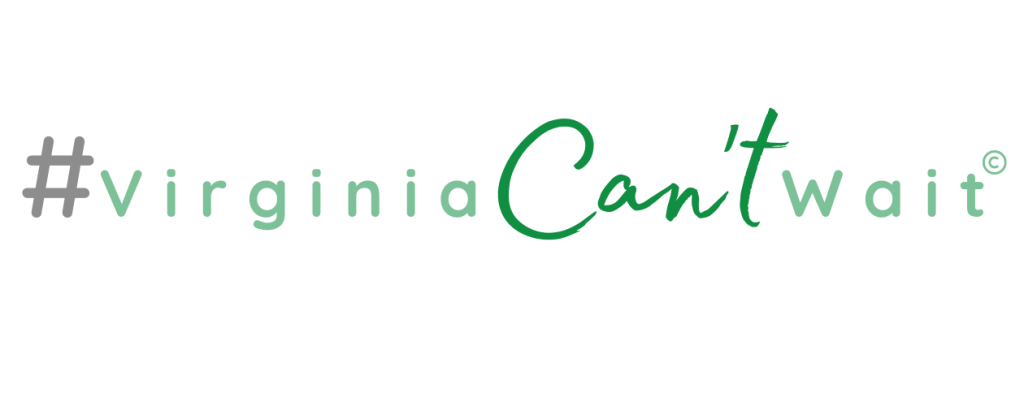
Action Item #2 (Years 2–5: Develop and initiate a Central and Southwest Virginia Resiliency Collaborative, which will include local and regional government representatives, as well as stakeholders from community, academic, and business groups, with the goal of aggregating educational efforts, encouraging local resiliency actions, and ensuring equitable representation as local, regional and state policies are being developed related to climate resiliency.
RESILIENT VIRGINIA STRATEGIC PLAN: JULY 2021–JUNE 2026
ORGANIZATIONAL AND FINANCIAL SUPPORT
Board of Directors
The Board of Directors members in the 2022 Fiscal Year are:- CHAIRPERSON: Ellen Graap Loth, Federal Services Market Leader, ECT
- SECRETARY: Jennie DeVeaux, PMP, Senior Consultant-Resilience, Witt O’Brien’s
- TREASURER: Vestal Tutterow, P.E., CEM, Program Manager, Lawrence Berkeley National Laboratory
- William Bohn, Chief Operating Officer, SOBIS Inc.
- Curtis Brown, Co-Founder, IDIEM
- Jonah Fogel, Ph.D, Program Manager, Environmental Resilience Institute, UVA
- Angela Orebaugh, Ph.D, Principal, Tomorrow-Today
- Chris Stone, E., F.NSPE, F.ASCE, LEED AP, Senior Principal and Vice President-Resiliency, ClarkNexsen
- Steven Sunderman, RA, LEED AP BD+C, BPI, President, Terrazia PC
Staffing
Resilient Virginia is managed by Annette Osso, LEED AP, Managing Director, who serves in a volunteer capacity. She was the President of VSBN for 18 years and brings 30+ years of experience in environmental, resiliency, sustainability, green building, and energy program development and management to Resilient Virginia. Additional staff in FY 2022 are Tracy Garland, Program and Development Director, and Trish Porter, Marketing and Communications Director, who serve in a part-time capacity. Website management and services are provided by Gerry Cervenka/Editype. Our goal is to expand financial support for the organization so that staffing positions can be expanded to full-time employment.Advisory Board
In 2021-22 fiscal year the Advisory Board Members were:- Elizabeth Andrews, Director, Virginia Coastal Policy Center, William & Mary Law School
- Sharon Baxter, Director, Division of Environmental Enhancement, Virginia Department of Environmental Quality
- Robin Jones, Program Manager, Virginia Department of Energy
- Denise Nelson, P.E., CFM, ENV SP, LEED AP, Director of Resilience and Grants, Launch! Consulting, Inc.
- Ann Phillips, Rear Admiral, U.S. Navy (Retired), Special Assistant to the Governor of Virginia for Coastal Adaptation and Protection
- Henry “Speaker” Pollard, Partner, Williams Mullen
- Cliona Robb, Director, ThompsonMcMullan
Partners
At its formation, Resilient Virginia initially engaged the support and participation of the Governor’s office, particularly the Office of the Secretary of Public Safety and Homeland Security, which was a major supporter of the 2017 Resilient Virginia Conference. We have also worked with the State Secretariats in the Natural Resources, Agriculture and Forestry, and Energy areas. We engage with key groups around the state. Our partners include:- Local public sector representatives, including planning district commissions, city and county governments, emergency management departments, and the state-level associations, Virginia Municipal League (VML) and the Virginia Association of Counties (VACO).
- State agencies with related programs, which include environment, energy, emergency management, agriculture, health, transportation, and economic and community development.
- Private sector representatives, including resiliency consultants and trade associations such as those representing civil engineers, water and wastewater companies, emergency management, the Green Building industry, and the energy industry.
- NGOs that work in related areas including agriculture groups, clean energy and environmental organizations, health and social welfare groups, and environmental justice, grassroots sustainability and affordable housing organizations.
- Academic institutions, including the major state universities, the community college system, and private universities, as well as maintaining the capacity to engage with the K–12 school districts.
Financial Support
Resilient Virginia has received private sector support from a variety of Annual Sponsors since its founding in 2014.- Marion Enterprises Inc.
- Witt O’Brien’s
- Facility Engineering Associates, PE
- Clark Nexsen
- Tetra Tech
- Daniel Michaelson
- Dewberry
- Hazen and Sawyer
- Leaders in Energy
- Sustainable Design Consulting
- 2rw Consultants
- Tomorrow-Today
- Balfour Beatty Construction
- Get Ready!
- Floyd EcoVillage
In addition, a wide range of public and private sponsors have supported the Resilient Virginia Conferences and our Resiliency Academy series, which are also supported by income from registration fees. Membership support is also being expanded and serves to strengthen continued growth in adding educational resources that comprise our Resiliency Hub, along with our other forms of communication.
We are continually working to secure new supporters in the private sectors that represent the broader resiliency areas. These include health care organizations, engineering and consulting businesses, insurance and risk management companies, and disaster recovery businesses. Resilient Virginia also continues to work to secure federal funds, and private business and foundation funding for aspects of the program plan, such as educational workshops and direct technical consulting services.
RESILIENT VIRGINIA STRATEGIC PLAN: JULY 2021–JUNE 2026
COMMUNICATION OF THE STRATEGIC PLAN
The Strategic Plan will be disseminated in several ways:- Every Board Member and Advisory Committee member will receive a copy of the plan;
- The plan will be posted in the Board google drive;
- A condensed version of the Strategic Plan will be available through the website;
- The Executive Summary will be available in marketing materials, such as newsletters, brochures, ads, etc.;
- Copies of the plan will be made available for major stakeholders, for example, funders/investors, trade associations, and potential collaborators.
RESILIENT VIRGINIA STRATEGIC PLAN: JULY 2021–JUNE 2026
EVALUATION OF THE STRATEGIC PLAN
Evaluation of the progress being made toward goals and action items outlined in the Strategic Plan will take place on an annual basis by the Board of Directors. The staff will develop a flow chart of tasks and staff/board responsibilities to assist in managing workload and the timeframe for tasks. A 12-month schedule of activities is included as Appendix C. Monitoring and evaluation will consider the following questions:- Are goals and objectives being achieved or not? If they are, then acknowledge, reward and communicate the progress. If not, then consider re-framing items to align goals with progress that is feasible to obtain.
- Will the goals be achieved according to the timelines specified in the plan? If not, then why?
- Should the deadlines for completion be changed? If that is a concern, deadlines should be changed only after fully understanding why they have not been met.
- Do personnel have adequate resources to achieve the goals?
- Are the goals and objectives still realistic?
- Should priorities be changed to put more focus on achieving certain goals?
- Should the goals be changed? If that is a consideration, goals should be changed only after fully understanding why they have not been met.
- What can be learned from the monitoring and evaluation in order to improve future planning activities and also to improve future monitoring and evaluation efforts?

